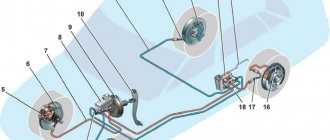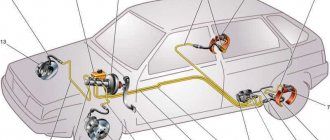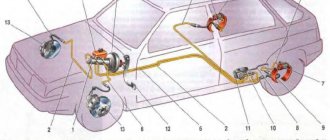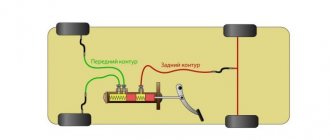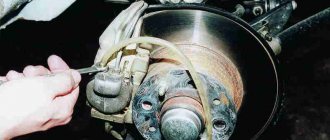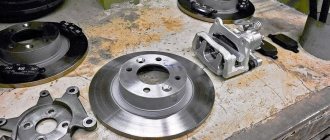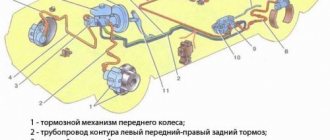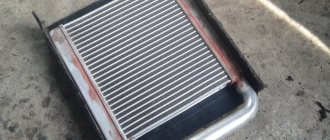The anti-lock braking system (abbreviated as ABS), which prevents the car from skidding during sudden braking, is installed on most passenger cars, including domestic ones. Since a considerable part of car enthusiasts are engaged in independent maintenance and repair of their “iron horses,” a logical question arises about how to properly bleed ABS brakes in a garage. To get a comprehensive answer, you need to find out how the new system differs from the old one and consider air removal technology.
Additional elements of brake circuits
The disadvantage of old brakes was that one or more wheels would lock when the pedal was pressed to the floor. As a result, the car lost control and skidded, especially on slippery roads. Later, the traditional system was modernized by adding the following elements:
- hydraulic valve block;
- electric pump;
- capacity - hydraulic accumulator;
- wheel rotation sensors;
- electronic control module (ECU).
The listed components and parts are components of the anti-lock braking system. Thanks to them, a car with ABS never skids, since the automatic system simulates repeated sharp presses on the brake pedal, although the driver presses it all the way.
There are 2 types of brake circuits on cars: three- and four-channel. In the first case, the front wheels are connected to the main brake cylinder by separate branches, and the two rear wheels are connected by a single circuit. In the second scheme, each wheel has its own liquid line.
To understand the difference between bleeding a brake system with ABS, it’s worth understanding its operation:
- When the driver brakes under normal road conditions, the sensors on the wheels record approximately the same deceleration (taking into account turning) and the ABS does not manifest itself at all.
- When you press the pedal sharply, one or more wheels lock and rotate slower than the others, which the sensor reports to the ECU.
- At the command of the controller, the hydraulic unit opens the corresponding valve and the pressure in the circuit of the stopped wheel drops. Excess brake fluid flows into a storage tank.
- The pads release the disc (or drum) and the wheel spins along with the rest. But since the goal is to brake quickly, the ECU switches the valves again, the pads “grab” and hold the disc until the sensor detects the lock again. The cycle repeats until it stops completely.
- To prevent pressure in the master cylinder from dropping during valve actuation, an electric pump replenishes the brake fluid by pumping it from the hydraulic accumulator.
One described cycle takes a fraction of a second. The interaction of the fluid circuits with ABS is felt when the pedal is fully depressed. Due to the rapid operation of the valves and the pumping of fluid, the driver feels a series of shocks.
Typical faults
There are very few malfunctions that occur in this part. These include stuck valves, misalignment, and leaks.
If the sorcerer is upset, he can be adjusted. And they determine whether adjustment is needed by the behavior of the car. If the setting is off, then when braking the car will throw from side to side. If the valves are stuck or the brake fluid is leaking, the part needs to be replaced. Theoretically, repairs are possible, but the complexity and cost make it unprofitable.
The regulator may fail to operate only in two cases - at the maximum possible load and at a speed limit above 80 kilometers per hour. In this situation, the speed does not drop quickly, so the rear axle is not unloaded.
Preparing for pumping
As a rule, air entering lines and units is associated with a malfunction or its elimination. It is necessary to remove air bubbles that interfere with effective braking after disassembling the calipers, disconnecting the pipes or repairing the master cylinder.
The operating algorithm of the automation and hydraulic unit present in the vehicle’s braking system provides for maintaining high pressure in the main fluid circuit. If the air removal procedure is started without proper preparation, liquid may be released. Therefore, before bleeding ABS brakes, the pressure must be reduced. This is achieved by pressing the pedal 20 times with the ignition off.
What you will need for work:
- WD-40 aerosol lubricant;
- a spanner for unscrewing the fittings on the working cylinders of the wheels;
- a plastic bottle and a tube that matches the diameter of the fitting;
- a supply of fresh brake fluid.
Important! If in your car the hydraulic accumulator, valve and pump units are installed in different places or combined with elements of another automatic system - ESP, then you should not attempt to pump them yourself. You will need a special scanner that interacts with the electronic valve control unit.
The last step before bleeding is to turn off the ABS. To do this, take the operating instructions, open the fuse diagram and find the one that is responsible for the operation of this system. Then remove it from the slot.
If the design of the front and rear suspension allows, then you don’t have to remove the wheels - unscrew the fittings from the inspection ditch.
Device Description
The design and principle of operation of this element are quite simple. At the moment when the rear part of the car body rises and the distance between the axle and the body increases, a special lever is activated, which is connected in a “sorcerer”. This lever lowers the piston, which closes the brake fluid channel, and accordingly the pressure on the rear pads decreases. The wheels do not stop rotating and, accordingly, do not skid.
The idea itself is quite clever, but, as often happens, in practice it raises doubts. After all, if when braking the brake pedal is pressed with great force, then the front wheels go into skid and the car still begins to skid. Quite often, when observing a traffic accident, you will notice that the cars with the “sorcerer” are turned backwards. Is this related to this miracle detail, which in its essence should prevent this skidding?
Air removal procedure
Bleeding the ABS brake system begins by treating all fittings on the working cylinders with WD-40 lubricant. During operation, they manage to rust and often break when trying to loosen them with a wrench. Then proceed according to the instructions:
- Open the expansion tank and add brake fluid to the MAX mark. During operation, monitor the level and constantly replenish the container so as not to fill the lines with new air.
- With the ignition off, disconnect the wires from the expansion tank cap.
- Place the transparent tube onto the front wheel cylinder fitting and unscrew it 1 turn.
- Press the brake pedal to the floor and do not release, which will cause fluid to leak out with air bubbles.
- When clean brake fluid comes out, tighten the fitting and release the pedal. Refill the reservoir and repeat the operation on the second front wheel.
ABS system and why it is needed
ABS - Anti-lock Braking System, which is now installed on almost all modern cars . The essence of the system is that it prevents the wheels from completely locking during sudden braking, thus, when braking sharply on a slippery road, the car does not skid, and the driver can drive the car as usual. Therefore, we recommend that you carry out a procedure such as bleeding the brakes in a timely manner .
The ABS system has the following components:
- the control unit, which receives signals from sensors, monitors how the valves operate;
- valves installed in the brake system, they dose the amount of brake fluid that flows to them;
- brake sensors, they are mounted on the wheel hubs, they transmit data about the speed of the car.
Video review in which bleeding ABS brakes is quite simple:
Adjusting the brake pressure regulator on VAZ 2108, VAZ 2109, VAZ 21099
Welcome! In today’s article, we will examine in detail a question that plagues many car owners, and it sounds like this: “How to adjust the sorcerer on cars of the Samara family?” After reading, the following question appears: “What kind of sorcerer are we talking about?” Let's explain! The sorcerer is the popular name for the brake pressure regulator; you will find this very word in the article.
Some subtleties when bleeding ABS brakes
Each car has its own characteristics, but in general, the design is approximately the same, so bleeding ABS brakes does not cause any difficulties . Let's take a closer look at the system and see if it is possible to bleed the brake system with ABS using your own handles.
- If the valves and the hydraulic accumulator are located far from each other, then in order to service the brakes you need a special scanner for diagnostics, which will read the sensor readings and decipher them. Such a diagnostic scanner can only be found in a service center.
- There are also mechanisms for bleeding the brake system, when valves, a hydraulic accumulator and a pump are located in one housing. In this option, you can carry out the process: bleeding the brakes and bleeding the brake system with your own hands. You need to turn off the ABS system - remove the corresponding fuse, and then bleeding the brake system will be the same as on older cars that did not yet have ABS.
- But there are cars with more complex systems such as ESP and others, then you will have to take such a car to a service center right away. By the way, on the Passat B6, the ABS system itself often fails, this is probably a disease of all Passats, because even on the good old Passat B 3 the same problem also happens.
"Chevrolet Niva"
"Chevrolet-Niva"
"Chevrolet-Niva"
The third state - we reduce the influence of the regulator by increasing the gap from the original one by 8 mm, that is, we set it to 24 mm. When there are two people in the car, the braking distance remains virtually unchanged - 34.3 m. However, now the rear wheels are blocked. But at full load the braking is very effective, the deceleration is easy to control and the result is a record: only 30.8 m!
- In the normal position of the regulator, as the vehicle's weight increases, its braking distance decreases - this affects the more complete use of the traction weight by the rear wheels.
- The best braking is at full load, when the regulator minimally limits the pressure in the rear brakes.
- However, at partial load this can lead to skidding. The high center of gravity and short wheelbase of the Shnivy contribute to a significant redistribution of mass during braking, therefore, at partial load, the contribution of the rear axle to braking is small.
Preparing for work
It is good to pump ABS brakes on an overpass or pit . Bleeding brakes with ABS, like bleeding a conventional brake system, is carried out with an assistant, starting the process of bleeding the brake system from the front wheels, then the rear (right and left). Shortly before starting work, it is recommended to inspect the threads of the brake bleeding fitting, for a smooth process: bleeding brakes
But first you need to determine what type of ABS system you have:
- If there is a simple ABS system, when all the components are in one housing, then it is enough to simply find the fuse, which in most cases is located in the system block. If you remove the fuse, the ABS system will be completely disabled. If you turn on the ignition, a light will come on, indicating that the ABS is faulty.
- Next, in the engine compartment, you need to find the cap on the expansion tank of the brake system and unscrew it. Before doing this, it is better to remove the connector from the electrical sensor.
- Then you need to look under the car, and near each wheel, find fittings for bleeding the working cylinders and loosen them. Here you need to make sure that the descenders do not break, because if they break, the work will take a long time. You can pre-treat the fittings with brake fluid or WD-40.
- In order to do the work accurately and at the highest level, you need to stock up on a flexible, clean hose whose internal diameter will be the same as the size of the fitting. And you need to pour about a third of the brake fluid into the bottle. By the way, you can buy brake fluid here: https://chaspik.org.ua/teh-jidkosti/tormoznyie-jidkosti/.
Let us remind you: bleeding of ABS brakes should be done by two people, for convenience and practicality. Pumping the brakes is also the key to successfully avoiding a collision. Bleeding the brakes is not an unimportant cog in this safety system.
Several ways to bleed the brake system
Let us remind you that bleeding the brakes is very important for accident-free situations on the roads; keep an eye on the ABS brake bleeding system . Bleeding ABS brakes is possible in several ways, and their implementation depends on the design of the entire complex. There are two ways to remove air from the brake system, but in any case, you will need an assistant. The process of bleeding a brake system with ABS cannot be considered labor-intensive or complicated.
Method No. 1
After completely disabling the ABS system, you need to do the following:
- First, you need to bleed the unit farthest from the master cylinder - the rear wheel on the right side. You need to put one end of the hose on the fitting, and lower the other end into a bottle of brake fluid. You need to have an assistant behind the wheel who will press the brake with your foot. And press until the air is completely removed.
- While the assistant holds down the gas pedal, you need to unscrew the fitting. After the liquid or air stops flowing, you must immediately tighten the fitting. This operation must be repeated several times if bubbles still come out of the working cylinder.
- Then you can move to the rear left wheel and do the same actions.
- After this, we move to the right front caliper, and finish pumping the brakes on the left front caliper.
- When each slave cylinder has been bled, it's time to look at how much fluid is in the expansion tank. The main thing is not to allow the brake fluid to completely drain from the reservoir, because then air will enter the system.
Method number 2. Using a special pump, bleed the brakes
If it is possible to connect a pump, then you can use this method to pump the brakes, but you will also need a partner for this . It is imperative that after the brake bleeding process is completed, before leaving, you need to check the tightness of the system and the absence of leaks. Check the brake fluid level.
- To bleed the right rear cylinder, you need to put a hose on the fitting on one side, and on the other side, also put the hose in a bottle with brake fluid. Then you need to unscrew the fitting about 1.5 turns.
- The assistant will also press the brake pedal and turn on the engine. The attached pump will create pressure in the brake line and expel all the air. After the bubbles stop flowing into the bottle, you just need to turn off the engine.
- The rear left wheel is pumped a little differently. The hose is attached to the fitting and lowered into the liquid, and the drain must be unscrewed 1 turn.
- Turn on the engine and when the bubbles enter the bottle of liquid, you will need to press the brake pedal about halfway, after which you need to quickly tighten the fitting.
- Then you can release the pedal and turn off the engine.
- The main thing is to add brake fluid to the reservoir on time.
- When bleeding of the brakes has come to an end, you need to tighten all the fittings, screw on the cap on the reservoir and reconnect all previously disconnected connectors. Look under the bottom and check how tight the pipelines, fittings and cylinders are. And if nothing leaks anywhere, then everything is fine with the car and you can drive safely. Good luck in completing the solution to the problem of bleeding brakes with ABS.
Why isn't one of the rear wheels bleeding?
The reason for the failure, if the rear left wheel on the Kalina does not bleed, is most often the reaction of the brake fluid pressure control device.
Rear brakes on Kalina
This occurs due to misalignment of the drive lever. Before pumping, it must be adjusted, and if unsuccessful, replaced.
One of the tubes is clogged or squashed
Often, driving on uneven roads and failure to comply with speed limits lead to damage to brake pipes and hoses. Kinks and other damage to tubes and reinforced hoses cannot be restored and must be replaced.
Pressure regulator faulty
Adverse environmental influences or inappropriate fluid for filling the brake system can lead to damage to the pressure regulator with the need for its subsequent replacement.
The pressure regulator drive is faulty or out of adjustment
When the rear left wheel on a Kalina does not bleed, you need to carefully inspect the pressure regulator drive device, which is a combined lever openly located under the bottom of the car and exposed to an aggressive environment.
Adjusting the brake pressure drive
Due to contamination and corrosion, its correct operation is impaired. You can try to restore it by adjusting it (it is adjusted with a nut at “13”, which fixes the position of the lever relative to the head of the pressure regulator rod).
Algorithm for pumping brakes with ABC
The first thing to do before bleeding ABS brakes is to reduce the internal pressure in the system, which can reach 180 atm.
Naturally, such pressure is unacceptable when carrying out work, so to reduce it, press the brake pedal 15 - 20 times, while the car’s ignition must be turned off.
The following describes the most common method of bleeding abs brakes. Naturally, this process may be different for each car model, so before performing any work yourself, read the instruction manual for your car.
The work is carried out with an assistant.
The ignition must be turned off. Disconnect the connectors on the brake fluid reservoir, unscrew the reservoir cap.
